#1st century B.C. – 1st century A.D.
Explore tagged Tumblr posts
Text

A Roman Bronze Romping Dog Circa 1st Century B.C.-1st Century A.D.
#A Roman Bronze Romping Dog#Circa 1st Century B.C.-1st Century A.D.#bronze#bronze statue#bronze sculpture#ancient artifacts#archeology#archeolgst#history#history news#ancient history#ancient culture#ancient civilizations#ancient rome#roman history#roman empire#roman art#ancient art
1K notes
·
View notes
Text

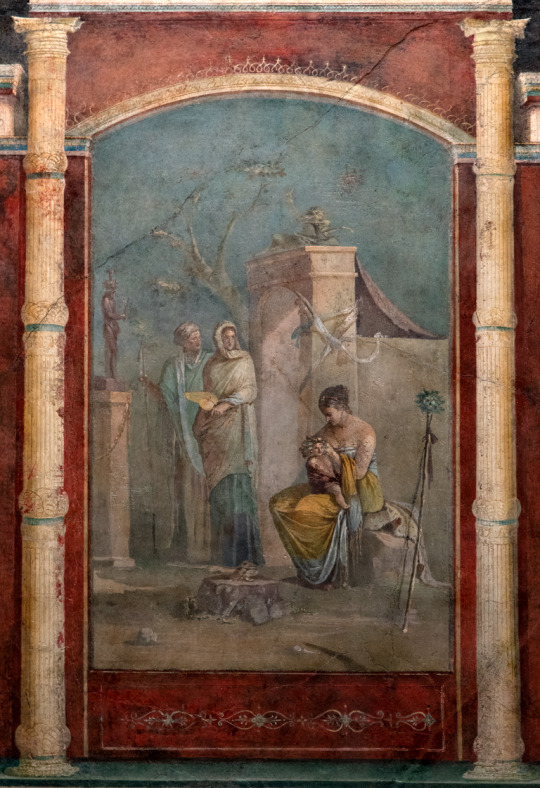
~ Childhood of Dionysos: From the cubiculum B of the villa Farnesina (Dionysos with the nymphs of Mt. Nysa, to whom Zeus has entrusted the care of his baby-son).
Date: 1st century B.C.-A.D. 1st century
Provinience: Roman National Museum, Palazzo Massimo alle Terme (Roma, Museo nazionale romano, Palazzo Massimo alle Terme).
#ancient#ancient art#history#museum#archeology#Roman#childhood of Dyonisos#villa farnesina#zeus#1st century B.C.#a.d. 1st century
775 notes
·
View notes
Text

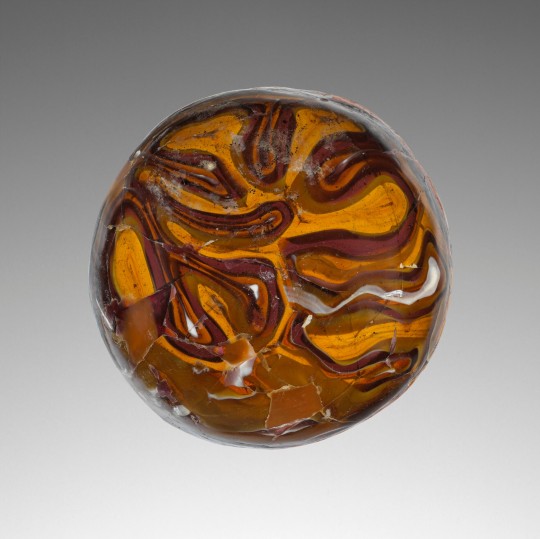


Roman glass bowl, end of 1st century B.C–1st century A.D
During the Roman Imperial period, the popularity of elite objects sculpted from colorful stones such as agate and onyx led to the development of a market in glass replicas. These affordable alternatives were cast or blown from multi-colored canes of glass and imitated expensive natural stones. Here, an ancient craftsman has created an abstract version of agate using brown and white glass.
To make the bowl, the artist heated a rod of multicolored glass and laid the molten glass onto a flat surface, spiraling it into the center in a serpentine pattern. While heating in a kiln, the glass would fuse slowly--each curve melding into the next--until it became one large, colorful disk. After brief cooling, the disk was placed atop a hemispherical mold and heated again, until it slumped into a bowl shape. In the final step, the completed bowl entered an annealing oven to cool slowly, a process that kept the glass from shattering.
Text by The J. Paul Getty Museum.
Public domain pictures. Getty's Open Content Program.
541 notes
·
View notes
Text
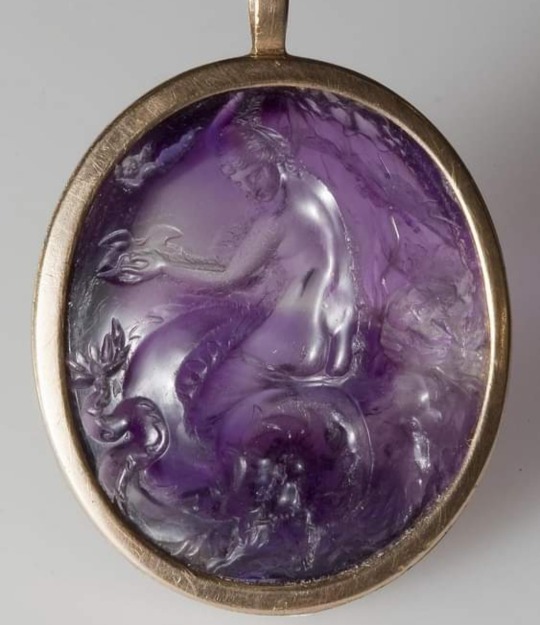
Amethyst Intaglio Circa 1st Century, B.C. - A.D. Roman, Possibly Carved by Master Gem Carver, Dioscurides, Who Was The Favorite Gem Carver Of Emperor Augustus
Source: Archeology and The Ancient Worlds via Facebook/Meta
#amethyst#intaglio#ancient jewelry#precious gemstones#high jewelry#luxury jewelry#fine jewelry#fine jewellery pieces#dioscurides#emperor augustus
477 notes
·
View notes
Text


16/11/24
Marble statue of Aphrodite
Roman, Imperial period, 1st or 2nd century A.D. Copy or adaptation of a Greek statue of the 3rd or 2nd century B.C.
The goddess of love is shown as though surprised at her bath. Originally, her arms reached forward to shield her breasts and pubis in a gesture that both concealed and accentuated her sexuality.
Statues of Aphrodite in the nude proliferated during the Hellenistic period. All were inspired to some degree by the Aphrodite of Knidos, created in the fourth century B.C. by the famous Greek sculptor Praxiteles. That statue, the first major Greek work to show the goddess nude, was celebrated throughout antiquity. This work has the same gesture of modesty and is similar to another Roman copy, the so-called Medici Venus, which has stood in the Tribuna of the Uffizi Gallery in Florence since 1688.
#photographers on tumblr#original photography#dark academia#dark academia aesthetic#classic academia#classic academia aesthetic#chaotic academia#chaotic academia aesthetic#art#greek mythology#cottagecore#cottagecore aesthetic#cottage aesthetic#dark cottagecore#nature photography#nature#naturecore#nature aesthetic#gardencore#earthcore#fairycore#fairy aesthetic#softcore#soft aesthetic#autumn#autumncore#autumn aesthetic
55 notes
·
View notes
Text
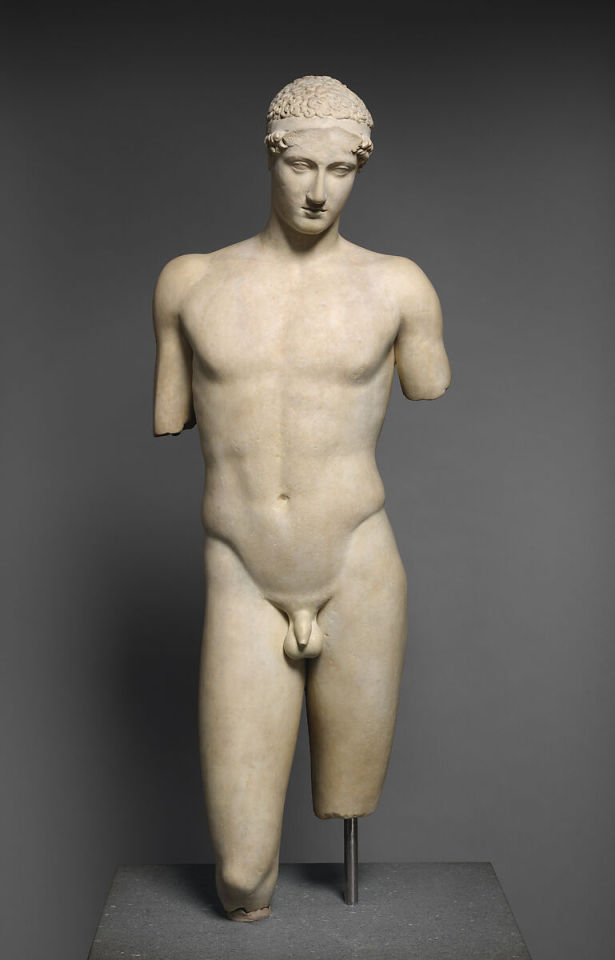

Stephanos Athlete, Roman, Early Imperial, Date late 1st century B.C. or 1st century A.D
#stephanos athlete#ancient art#ancient sculpture#marble sculpture#art history#roman art#roman history
268 notes
·
View notes
Text
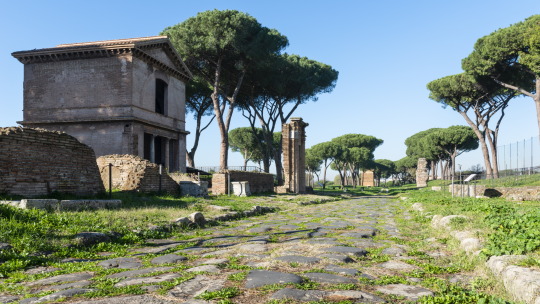
Antigua Via Latina / The ancient Via Latina
In the middle of the Roman periphery, between the modern Via Appia and Via Tuscolana, a section of the 3rd mile of the ancient Via Latina is preserved in perfect condition.
It has ancient origins: the natural route, already followed in prehistoric times, was used by the Etruscans to colonise Campania in the 8th-6th centuries BC.
Definitely laid out by the Romans around the IV-III centuries B.C., it connected Rome with Capua, maintaining its importance throughout Antiquity. In fact, even in the Middle Ages, it was preferred as an access road to Naples because of its better preservation compared to the Appian Way and the presence of a number of Christian places of worship along the route..
Entering the Archaeological Park of the Tombs of the Via Latina, it is now possible to walk along a section of the original paving of the street. With a pleasant walk you can admire the rich tombs dating back to the I-II century A.D. that overlooked the route, which still have perfectly preserved polychrome decorations on the façades and inside: vaults covered with painted plaster and stucco, walls frescoed with funerary scenes and rich mosaic floors are still substantially intact in their original context.
From the street it is also possible to reach the Basilica of S. Stefano, a rare example of an early Christian building erected under the pontificate of Leo the Great in the middle of the 5th century.
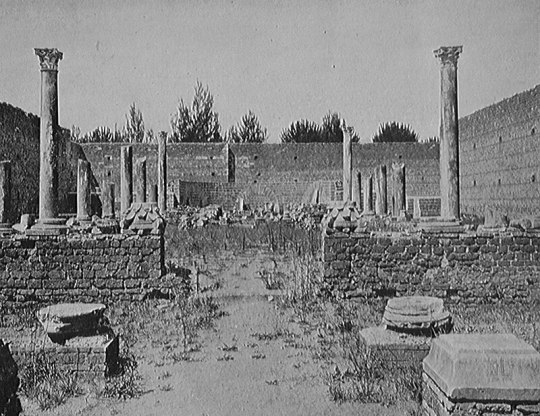
Santo Stefano en Vía Latina, restos parcialmente reconstruidos, 1911.
Santo Stefano in Via Latina, partially reconstructed remains, 1911.
The Archaeological Park of the Tombs of the Via Latina was created in 1879 following the acquisition by the State of a vast area in which important remains from Roman times had been discovered.
BARBERINI TOMB
The so-called Barberini Sepulchre, or Sepulchre of the Corneli. The funerary monument, dating from the 2nd century AD, consists of two above-ground floors and a hypogeum in an excellent state of preservation. The upper floor is covered by a ribbed vault completely covered with plaster painted with a red background and stucco elements. Groups of figures, winged victories on chariots, love affairs, birds, marine animals, mythological themes and architectural backgrounds can be recognised.
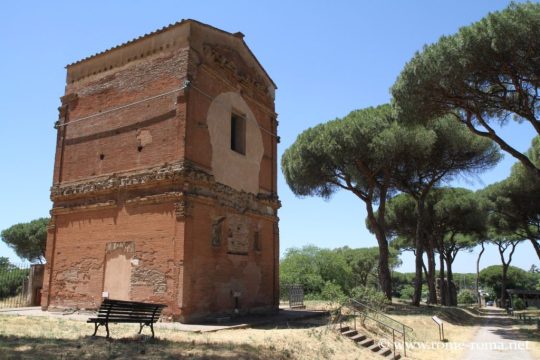
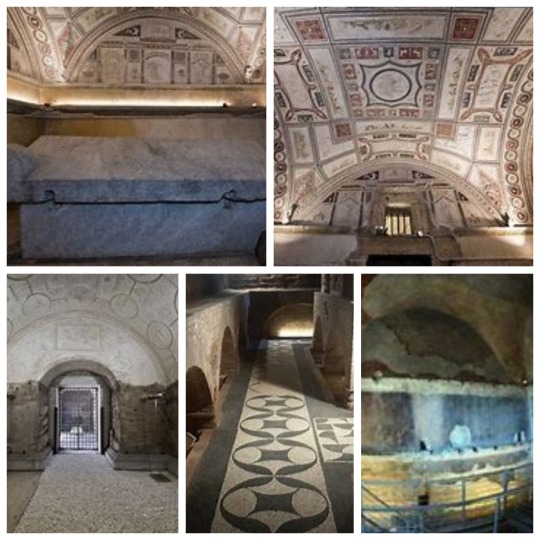
Sepulcro Barberini y su interior / Barberini Tomb and its interior
TOMB OF THE VALERI
The Tomb of the Valeri. The richly decorated underground rooms dating from the mid-2nd century AD are preserved, while the elevation is a hypothetical reconstruction dating from the mid-19th century. An elaborate white stucco covering, articulated in 35 medallions and panels, adorns the lunettes and the barrel vault of the underground room. The medallions depict Dionysian themes, female figures and sea animals, while in the central tondo there is a delicate-veiled figure on the back of a griffin, representing the deceased being carried to the afterlife.


Tumba de los Valeri, exterior e interior / Tomb of the Valeri, exterior and interior
THE TOMB OF THE PANCRATII
The Tomb of the Pancratii. Much of the visible structure is a modern construction that protects the monument below by resting on the original 1st-2nd century AD walls, about a metre high. Upon entering the tomb, one can admire the beautifully decorated underground rooms, with mosaics on the floors and vaults and walls frescoed in bright colours and stucco in an excellent state of preservation. They depict mythological scenes, natural and architectural landscapes, images of women and animals. In the centre of one of the underground chambers is a large sarcophagus for two Greek marble depositions.

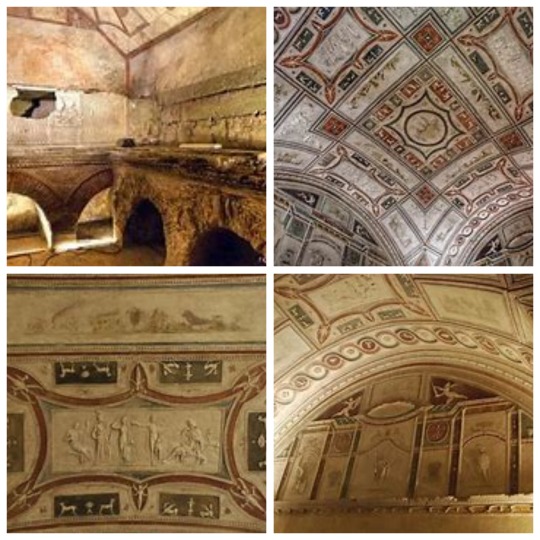
Sepulcro de los Pancracios, exterior e interior / Tomb of the Pancracios, exterior and interior
81 notes
·
View notes
Text
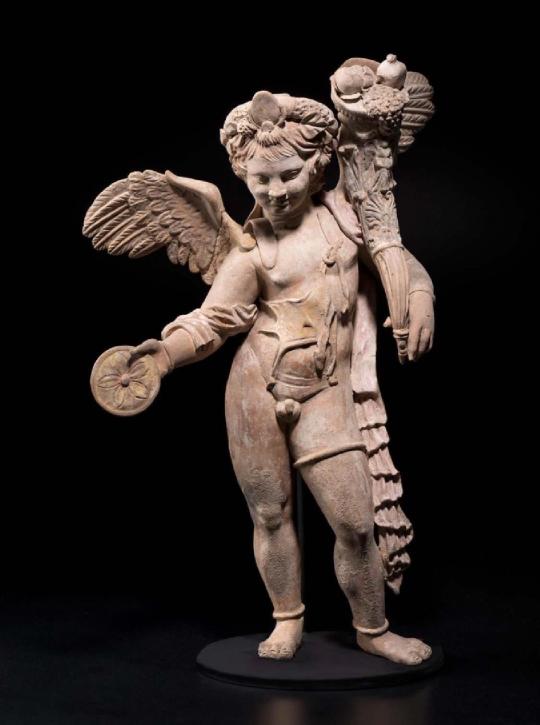
Statuette of Eros as Harpokrates carrying a cornucopia the Diphilos' workshop Greek, East Greek Hellenistic or Imperial Period late 1st century B.C. – early 1st century A.D.
#esoteric#consciousness#metaphysical#occult#rosicrucian#tarot#alchemy#magic#alchemist#art#magick#magical
185 notes
·
View notes
Text
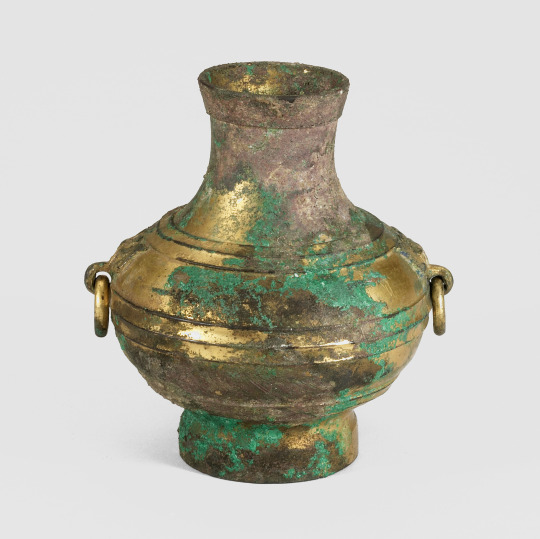
Wine Jar (Hu)
China, Style of Western Han dynasty (206 B.C.–A.D. 9), 2nd/1st century
64 notes
·
View notes
Note
hey so what do you think of the fact that Hades was seen as an anti Zeus and an equal to Zeus
Ovid, Fasti 4. 443 (trans.Boyle) (Roman poetry C1st B.C. to C1st A.D.) "[Zeus speaks :] ‘My rank is no greater [than Haides]. I hold court in the sky; another rules the sea [Poseidon], and one the void [Haides].’"
Seneca, Hercules Furens 53 (trans. Miller) (Roman tragedy C1st A.D.) "Dis [Haides] himself, who drew a lot equal to Jove's [Zeus's]."
I usually like to use the older sources as well in order compare them. Even in the Iliad and Homeric Hymns to Demeter Hades seems to be treated on equal foot with Zeus, so this is a general idea ancient people had on him, rather than a "1st Century Idea" or "Something completely baseless stupid Ovid randomly came up with." (Though I think it should be also be pointed out the fact that Ancient Greeks feared Hades more, and he started to be actually worshipped by the romans, to put it roughly.)
Homer, Iliad 15. 187 ff (trans. Lattimore) (Greek epic C8th B.C.) : "We are three brothers born by Rheia to Kronos (Cronus), Zeus, and I [Poseidon], and the third is Aides [Haides] lord of the dead men. All was divided among us three ways, each given his domain. I [Poseidon] when the lots were shaken drew the grey sea to live in forever; Aides drew the lot of the mists and the darkness, and Zeus was allotted the wide sky, in the cloud and the bright air. But earth and high Olympos are common to all three."
Homeric Hymn 2 to Demeter (trans. Evelyn-White) (Greek epic C7th - 4th B.C.) : "Aidoneus Polysemantor (Ruler of Many), is . . . your [Demeter's] own brother and born of the same stock : also, for honour, he has that third share which he received when division was made at the first, and is appointed lord of those among whom he dwells."
To me it basically shows how different ancient people's perception was on him, compared to the modern views. I've usually seen people picking two extremes based on the fact that he's the King of the Underworld, where he's portrayed either as:
a) A satanic figure because they apply a Christian mentality on a Hellenistic Polytheistic religion and associate Mount Olympus with Heaven and the Underworld with Hell (and by extension Hades is treated like some sort of a Luciferian type of being; basically Paradise Rot meets Greek Mythology),
...or...
b) A misunderstood guy who unfairly got the Underworld during the division of the Cosmos and deserved better than the corpse cellar. Based on this interpretation/misconception people usually start making lots of headcanons that are further spred as facts, such a "Hades was the one who deserved to be King of the Gods but Zeus tricked him." or "Hades was hated even by his own family just because he was the god of the dead."
The problem in both of these cases is that the Underworld is perceived from a negative perspective, as something inferior, deplorable, therefore leading to this very popular (and shallow) idea that Zeus got the best and Hades the worst. When in reality, the Underworld itself comes with some great peaks as well. Besides the fact that you're disproportionately rich, every person who died eventually becomes your subject. Since Zeus rules the "Aboveworld", I personally like to perceive it as a beautiful metaphor: you start in the realm of Zeus and end up in the realm of Hades (hence the Anti-Zeus).
Ancient people feared him and avoided writing or saying his name because of the nature of his kingdom; because - quess what - people usually don't like dying (and considering the fact that back then lots of them were passing away at very young ages due to disturbing causes I can tell why).
9 notes
·
View notes
Text







Fragments of Roman glass, 1st century B.C.–1st century A.D.
via Getty
12 notes
·
View notes
Text

HELLENISTIC GOLD RING WITH GALLEY GEMSTONE 1ST CENTURY B.C.-2ND CENTURY A.D.
#HELLENISTIC GOLD RING WITH GALLEY GEMSTONE#1ST CENTURY B.C.-2ND CENTURY A.D.#gold#jewelry#ancient jewelry#ancient artifacts#archeology#archeolgst#history#history news#ancient history#ancient culture#ancient civilizations#ancient greece#greek history#ancient art
204 notes
·
View notes
Text


~ Bronze handle attachment in the form of a mask.
Period: Late Hellenistic or Early Imperial
Date: 1st century B.C.–A.D. 1st century
Culture: Greek or Roman
Medium: Bronze
#ancient#ancient art#history#museum#archeology#ancient sculpture#ancient history#archaeology#greek#roman#mask#Hellenistic#imperial#handle attachment#1st century B.C.#a.d. 1st century
1K notes
·
View notes
Text
Accessibility statementSkip to main content
Resubscribe
OPINIONSEditorialsColumnsGuest opinionsCartoonsSubmit a guest opinionToday's Opinions newsletter
This Easter, let’s not try to pretend Jesus was a ‘Palestinian Jew’
By Paula Fredriksen
March 28, 2024 at 6:00 a.m. EDT
Paula Fredriksen, Aurelio professor of scripture emerita at Boston University, is a historian of ancient Christianity and the author of “When Christians Were Jews” and “Jesus of Nazareth, King of the Jews.”
Easter marks the resurrection of Jesus, but this year the holiday comes with a twist: Jesus resurrected as Palestinian. Never mind that Jesus was born and died a Jew in Judaea. From the pronouncement of a member of Congress to the pages of the Encyclopaedia Britannica, Jesus is now heralded as a “Palestinian” or, more delicately, as a “Palestinian Jew.”
Jesus made an appearance on social media as a “Palestinian” around Christmas, and the meme has flourished since then. The gambit casts 1st-century Jews in the role of an occupying power and “Palestinians” as their victims. Just as Herod, the king of Judaea in Jesus’ time, persecuted the “Palestinian” holy family of Jesus, Mary and Joseph, so, too, goes the claim, is modern Israel an occupying power persecuting Palestinians today.
So caught up were these advocates in their own spin that they mischaracterized reality. In a Christmastime post on Instagram, Rep. Alexandria Ocasio-Cortez (D-N.Y.) condemned modern Israelis as “right-wing forces violently occupying Bethlehem.” But Bethlehem has been administered by the Palestinian Authority since 1995. Once a significant majority there, the Christian population plunged from 86 percent in 1950 to less than 12 percent in 2016.
As for the Gaza Strip, it is even less hospitable to Christians. As the New Yorker reported in January, a count by the Catholic Church in Gaza, “once home to a thriving Christian community,” found just 1,017 Christians, amid a population of more than 2 million. After seizing control of Gaza in 2007, Hamas ended the designation of Christmas as a public holiday and discouraged its celebration. The dwindling population of Gazan Christians has been harassed, intimidated, even murdered. Were Jesus to show up in modern-day Gaza, he would find an extremely hostile environment.
So how did Jesus end up “Palestinian”?
Roughly 3,000 years ago, on the eastern rim of the Mediterranean, a coastal confederation of five cities stretched from Gaza into Lebanon. The Bible refers to this zone as Philistia, the land of the Philistines. In 430 B.C., the Greek historian Herodotus, translating this term, gestured toward the broader area as “Palaistinē.”
To the east, the region of the biblical highlands was called Yehudah. The name predates Herodotus by centuries. By Jesus’ lifetime, the Romans labeled this whole area, coast and highlands together, as “Judaea,” a Latinization of “Yehudah.” The people living in Judaea were called “Iudaei”: “Judeans” or “Jews.” Their temple in Jerusalem, the focus of their ancestral worship since the first millennium B.C., was sacred to Jesus, which is why the gospels depict him as journeying there for pilgrimage holidays. An ethnic Judean, Jesus was, accordingly, a Jew.
Where, then, did the name “Palestine” come from? From a foreign imperial colonizing power: Rome. Judeans revolted twice against the Romans. The first revolt, from A.D. 66 to 73, reached an awful climax with the destruction of the Jewish temple in Jerusalem. Still, Rome kept “Judaea” as the region’s designation. But in A.D. 132-135, the Jews again revolted. By that point, Rome had had enough. The empire changed the administrative name of the region to “Syria-Palestina” — a full century after Jesus’ death. It was a deliberate way to “de-Judaize” the territory by using the throwback term for the coastal Philistines.
What does this mean? It means that Jesus was not “Palestinian.” Nor was he a “Palestinian Jew.” This is so for a simple reason: There was no political entity called “Palestine” in his lifetime. If Jesus was born in Bethlehem, he was born in Judaea as a Jew. He certainly died as one, under Rome’s heavy hand — the political condition that led to the two Jewish revolts.
It was Roman colonizers who changed the name of Judaea to Palestine.
Why rehearse this well-known history? Because now, in the current crisis, even Jesus is being enlisted for attacks on Israel. Calling Jesus a “Palestinian” or even a “Palestinian Jew” is all about modern politics. Besides being historically false, the claim is inflammatory. For two millennia, Jews have been blamed for Jesus’ execution by the Romans; casting him as a Palestinian just stokes the fires of hate, using Jesus against Jews once again.
It is, further, an act of cultural and political appropriation — and a clever rhetorical move. It rips Jesus out of his Jewish context. And it rips 1st-century Jews — and 21st-century Israeli Jews — out of their ancestral homeland, turning them into interlopers. This is polemic masquerading as history.
There have already been too many casualties since Oct. 7. Let’s not allow history to be one of them.
17 notes
·
View notes
Text

Glass mosaic ribbed bowl late 1st century B.C.–early 1st century A.D. x
42 notes
·
View notes
Text


16/11/24
Marble statue of Hermes
Roman, Imperial period, 1st or 2nd century A.D. Copy or adaptation of a Greek statue of the late 5th or early 4th century B.C.
The statue is almost intact, although the surface was strongly cleaned as was the custom in the eighteenth century. During that period, newly excavated ancient sculpture was cleaned and restored in Roman workshops before being sold to members of the European nobility. This work was acquired by the English statesman William Fitzmaurice, second earl of Shelburne, who assembled a distinguished collection of antiquities at Lansdowne House in London. The statue of Hermes once stood in a niche in the dining room at Lansdowne House, serving the same decorative function that it doubtless once served in a Roman villa of the first or second century A.D. The dining room, designed by Robert Adam, is now at the Metropolitan Museum, where it is installed with other period rooms from England.
#photographers on tumblr#original photography#dark academia#dark academia aesthetic#classic academia#classic academia aesthetic#chaotic academia#chaotic academia aesthetic#art#greek mythology#cottagecore#cottagecore aesthetic#cottage aesthetic#dark cottagecore#nature photography#nature#naturecore#nature aesthetic#gardencore#earthcore#fairycore#fairy aesthetic#softcore#soft aesthetic#autumn#autumncore#autumn aesthetic
31 notes
·
View notes